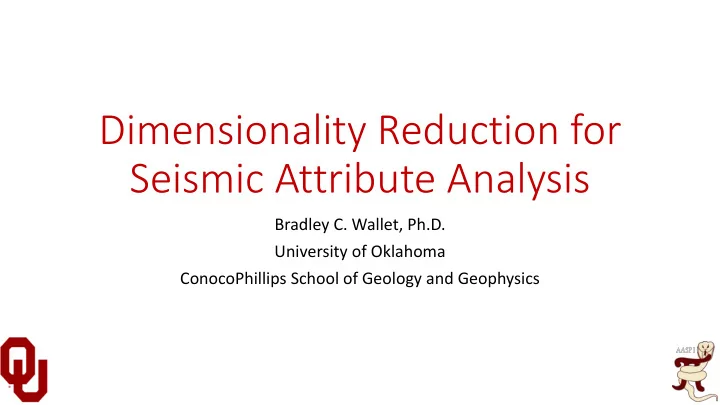

Dimensionality Reduction for Seismic Attribute Analysis Bradley C. Wallet, Ph.D. University of Oklahoma ConocoPhillips School of Geology and Geophysics
Where oil is first found is in the minds’ of men - Wallace Pratt
Motivation
Motivation
Outline • Seismic data • Seismic attributes • PCA • Image grand tour • Non-linear methods • Conclusions • Acknowledgements
Outline • Seismic data • Seismic attributes • PCA • Image grand tour • Non-linear methods • Conclusions • Acknowledgements
Why care about seismic data? • Single pre-stack data sets can be 10’s – 100’s of terabytes in size • Provide good spatial coverage exploration area • Used to make high dollar decisions
Seismic shot Courtesy of Bin Lyu
Common midpoint gather
Migration
Convolutional model Reflection Lithology Velocity Density Impedance Wavelet Coefficients Shale ⇒ ⇒ Sand x = * Shale Sand Shale
Seismic data (Elebiju et al., 2009)
Outline • Seismic data • Seismic attributes • PCA • Image grand tour • Non-linear methods • Conclusions • Acknowledgements
These are features
From one comes many Seismic data Attribute 1 Attribute 2 Attribute 3 Attribute 4 Attribute 5 Attribute 6 Attribute 7 Attribute 8
Coherence inline inline
Seismic 5 km (Bahorich and Farmer, 1995)
Coherence Coh 1.0 0.6 5 km salt (Bahorich and Farmer, 1995)
Σ Spectral decomposition Reflectivity Synthetic CWT Magnitude Voices CWT magnitude pos 0 Le Nozze di Figaro (Matos and Marfurt, 2011)
Spectral decomposition A ′ A Time (s) 30 Hz 15 Hz A A A ′ A ′ 30 Hz Map (Laughlin et al., 2002) 15 Hz Map
Spectral decomposition 18 Hz Red 24 Hz Green 36 Hz Blue (Bahorich et al., 2002)
Dip attributes z θ (dip magnitude) φ (dip azimuth) n a θ y θ x (crossline dip) (inline dip) ψ y x (strike) (Marfurt, 2006)
Dip attributes Minimum dip tested (-20 0 ) Dip with maximum coherence (+5 0 ) Analysis Point Maximum dip tested (+20 0 ) Instantaneous dip = dip with highest coherence (Marfurt et al, 1998)
Dip attributes Dip Azimuth Hue 0 180 360 High Dip Magnitude Saturation 0 N 1.2 E W 1.4 S (c) (Guo et al., 2008)
How do we “assimilate” all these attributes?
Outline • Seismic data • Seismic attributes • PCA • Image grand tour • Non-linear methods • Conclusions • Acknowledgements
PCA • Rotates attribute space • New dimensions are called principal components • Var(pc1) > Var(pc2) > … > Var(pc d) • Defines variance as information
PCA (Wikapedia)
Watonga survey
Complex PCA
Complex PCA
PCA
PCA
PCA
Outline • Seismic data • Seismic attributes • PCA • Image grand tour • Non-linear methods • Conclusions • Acknowledgements
Linear projections Poorly separated Well separated Somewhat separated ξ d ∑ = α ξ proj ( ) i i = i 1
The Grand Tour (1750-1880’s)
Defining the tour
Image Grand Tour 7.005 -6.215 10.95
View Locked Color IGT
Outline • Seismic data • Seismic attributes • PCA • Image grand tour • Non-linear methods • Conclusions • Acknowledgements
Latent spaces
Generative topographical maps a) N b) Cartoon illustration of GTM
Waka 3D Canterbury Basin, offshore New Zealand 170° 30’ E 173° 00’ E 45° 30’ S 46° 30’ S (Modified from Mitchell and Neil, 2012) (Figure by Origin Energy)
Seismic 36
Peak Frequency
Peak spectral magnitude 38
Curvedness 39
GLCM homogeneity 40
Co-rendering 41
GTM
Waveforms as attributes (Wallet et al, 2009)
Watonga revisited (Wallet et al, 2009)
Diffusion maps Form n-by-n similarity matrix Normalize rows to sum to 1 Perform PCA on diffusion matrix
Diffusion maps Advantages Disadvantages • Closed form solution • Computationally intractable for reasonable sized data sets • Direct calculation of inter-point distances • Out of training set data are not defined in mapping • Not tied to a Euclidean space • Eigenvalues
Diffusion maps
Outline • Seismic data • Seismic attributes • PCA • Image grand tour • Non-linear methods • Conclusions • Acknowledgements
Conclusions • The human is still the best interpreter we have • Attribute overload can overwhelm interpeters • Dimensionality reduction produces highly interpretable images
Acknowledgments • Prof. Kurt Marfurt (University of Oklahoma) • Mr. Victor Aarre (Schlumberger Norway Technology Center) • Mr. Tao Zhao (OU) • Dr. Marcilio de Matos (Petrobras) • CGG Veritas, Chesapeake Energy, Anadarko Petroleum, and the Government of New Zealand
Acknowledgments
Questions? bwallet@ou.edu http://geology.ou.edu/aaspi
Recommend
More recommend